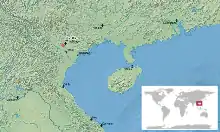Leptolalax sungi
Leptolalax sungi (Sung toad or Sang's metacarpal-tubercled toad) is a frog species in the family Megophryidae. It is found in Vĩnh Phúc and Lào Cai Provinces in northern Vietnam and in Guangxi in southern China.[2] Its natural habitats are subtropical moist lowland forests, moist montane forests, and rivers. Its status is insufficiently known.[1] This species was first found along a stream near Tam Đảo village, about 925 meters ASL.[3]
| Leptolalax sungi | |
|---|---|
| Scientific classification | |
| Domain: | Eukaryota |
| Kingdom: | Animalia |
| Phylum: | Chordata |
| Class: | Amphibia |
| Order: | Anura |
| Family: | Megophryidae |
| Genus: | Leptolalax |
| Species: | L. sungi |
| Binomial name | |
| Leptolalax sungi Lathrop, Murphy, Orlov and Ho, 1998 | |
 | |
Description
Leptolalax sungi are the largest frogs in the genus Leptolalax: males measure 48–53 mm (1.9–2.1 in) and females 57–59 mm (2.2–2.3 in) in snout-vent length. Their back is granular with distinct tubercles but uniform in colour or with light spots. The sides have small dark spots. They have iridescent gold-green irises.[4]
References
- IUCN SSC Amphibian Specialist Group. 2017. Leptolalax sungi. The IUCN Red List of Threatened Species 2017: e.T57575A47153198. http://oldredlist.iucnredlist.org/details/57575/0 Downloaded on 27 September 2017.
- Frost, Darrel R. (2013). "Leptolalax sungi Lathrop, Murphy, Orlov, and Ho, 1998". Amphibian Species of the World 5.6, an Online Reference. American Museum of Natural History. Retrieved 26 September 2013.
- Thompson, Christian (2008-12-15). "First Contact in the Greater Mekong" (pdf). World Wildlife Fund. Retrieved 2008-12-20.
- Ohler, A.; K. C. Wollenberg; P. Grosjean; R. Hendrix; M. Vences; T. Ziegler; A. Dubois (2011). "Sorting out Lalos: description of new species and additional taxonomic data on megophryid frogs from northern Indochina (genus Leptolalax, Megophryidae, Anura)". Zootaxa. 3147: 1–83.
